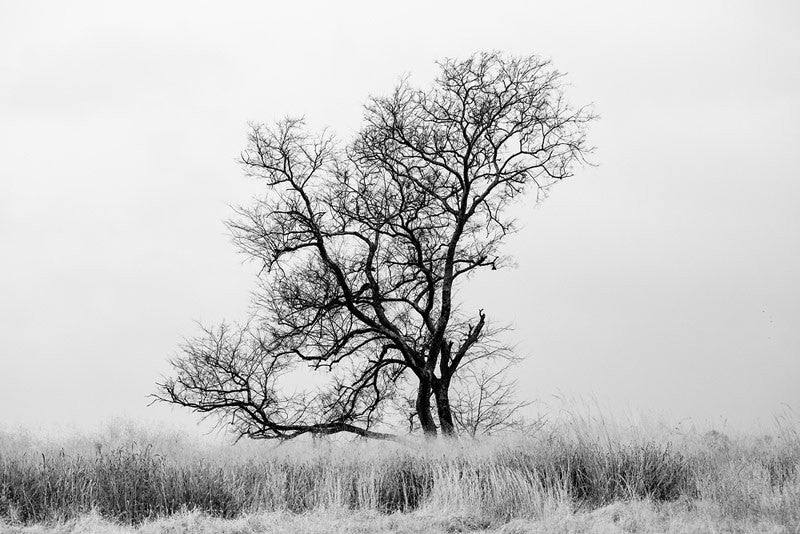
Even the simplest landscape photographs can have dramatic back stories
This is Keith Dotson's black and white landscape photograph called "McFadden's Old Tree." Photographed in the stark light of winter, amidst tumultuous waves of tall yellow grass, the barren tree appears dark and dramatic.
The video shows the same tree on the old McFadden farm in Tennessee. It may look like an ordinary tree in the middle of a bucolic pasture, but this tree has stories to tell.
First of all you see, this tree has bodies buried beneath it.
That's right, it's a cemetery tree, located on a low hill, not far from the Stones River. Buried beneath the tree is the former owner of the property, Samuel McFadden. With him are a few others, mostly unidentified. Samuel purchased the farm in 1818 and died in 1848, leaving behind his wife Hollie and 14 children who continued to live on the farm.
Witness tree
And it's an old tree as well. It's what's referred to as a "witness tree." A witness tree is one that's so prominent that it was used as a landmark for surveyors in marking off original land grants and property surveys. Witness trees were carved with a special symbol in their trunks, and noted on surveyors' field reports.
Backdrop to a Civil War battle
Now, let's add another layer to the story. This tree is also located on a historic Civil War battlefield site — one where thousands of men lost their lives. 15 years after the death of her husband, Hollie McFadden's farm became occupied by Union troops, leading to near complete devastation of her house and property.
By 1863, the city of Murfreesboro had been surrounded by battlefields, with bitter fights at several points near the railroad tracks and the Nashville Pike. Union guns had been pointed at the town center as part of an ultimatum to Confederate generals. The bloody battle at McFadden's Farm was the decisive finale to the fighting at Murfreesboro. A line of cannons 700 yards wide was positioned atop the hill very near the big tree on McFadden's farm.
The McFadden farm site was chosen because it sits near a ford in the Stones River. Incoming Confederates pushed retreating Federal troops back across the river, and at a late hour on a rainy January afternoon, Southern generals made the unexpected and fateful decision to follow the retreating troops in hot pursuit, with the intention to attack.
The Northern army was surprised by the decision, assuming that further fighting would be held until the next day. But their cannons were in position and ready to repel the rushing Confederate forces as they crested a ridge on the other side of the river.
A commemorative plaque on the site tells the story:
"On January 2nd, 1863 at 3:00 PM, there were stationed on the hill fifty-eight cannon, commanding the field across the river, and as the confederates advanced over this field, the shot and shell from these guns, resulted in a loss of eighteen hundred, killed and wounded, in less than an hour."
Author Peter Cozzens vividly describes the horror of the scene, as those 58 heavy Union guns unleashed a rain of iron and fire onto the heads of the charging Confederate soldiers — the trembling of the Earth, splinters and timbers from exploded cedar trees flying through the air, the whirring sound of the missiles, and the groans and screams of the wounded.
Cozzens also tells the story of Ohio soldier William Erb, who, before the battle, had searched a nearby barn (it might have even been the McFadden's barn), and had discovered a hen and her eggs. Having not eaten for three days, he and his comrades excitedly put the chicken in a pot, but then heard the call to arms before having the chance to partake.
But the Confederate attackers were so quickly repelled by Union cannon fire that Erb was able to return to his campsite to discover his cracker box riddled with bullet holes, but his chicken pot still warm and undisturbed (Cozzens page 192).
As for the McFaddens, all 14 children survived to adulthood, a very rare occurrence in the 1800s. Later records refer to a shopkeeper in town named Samuel McFadden, surely a son, and granddaughter Elvie McFadden, who taught in public schools for several decades.
But their old tree still stands.
Keith has returned to this landscape and this tree on many occasions. Regarding a 2016 storm that damaged the old tree, Keith said, "Sadly, the storm brought down nearly half the mass of the big tree, but it's still magnificent. I'm happy I was able to capture it for posterity."
Scroll down for more photographs of the tree.
Photographs of the historic old tree on McFadden's Farm
Black Tree in the Tall Grass (A0009257). Click to buy this photograph.
Graveyard on McFadden Farm (IMG_0358). Buy a fine print of this photograph.
McFadden Cemetery (IMG_8433). Buy a print here.
McFadden's Old Tree (A0009266). Black and landscape photo by Keith Dotson.
Sources
civilwar.org/hallowed-ground-magazine
http://www.civilwar.org/hallowed-ground-magazine/winter-2012/army-cumberland-stones-river.html?referrer=https://www.google.com/
Cozzens, Peter, "No Better Place to Die: The Battle of Stones River," page 192
Harber, Susan, "Harber’s History: McFadden’s Ford was a Civil War travesty," The Daily News Journal, Dec. 10, 2010
http://www.dnj.com/story/news/2016/12/10/harbers-history-mcfaddens-ford-civil-war-travesty/95101572/





Leave a comment